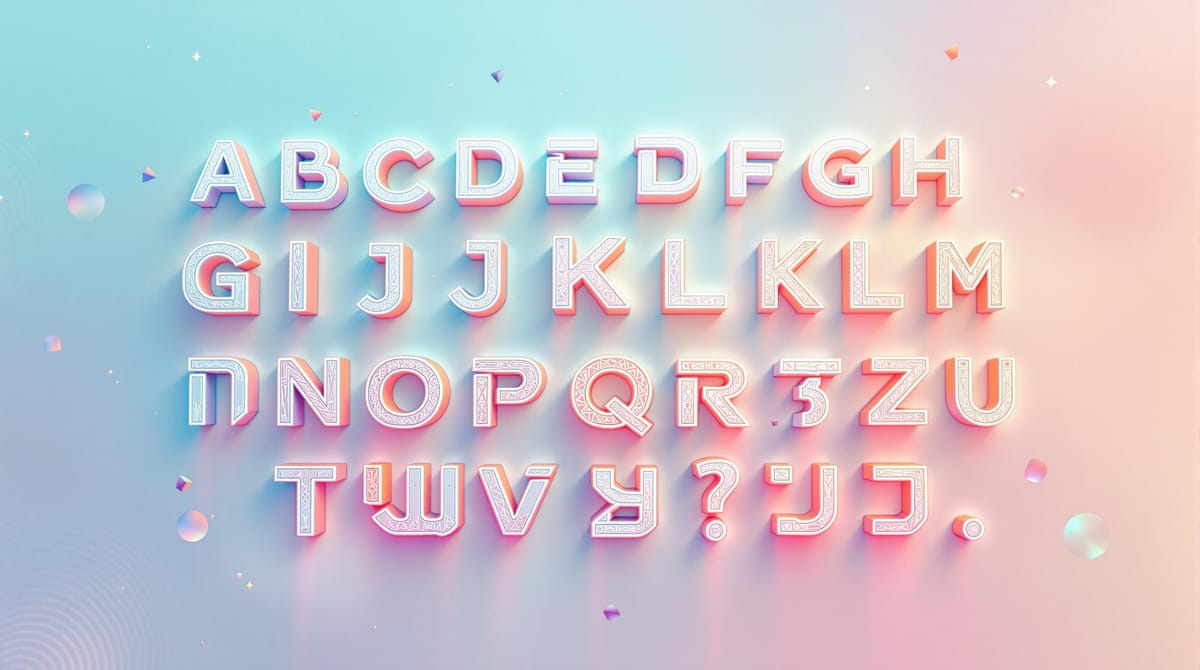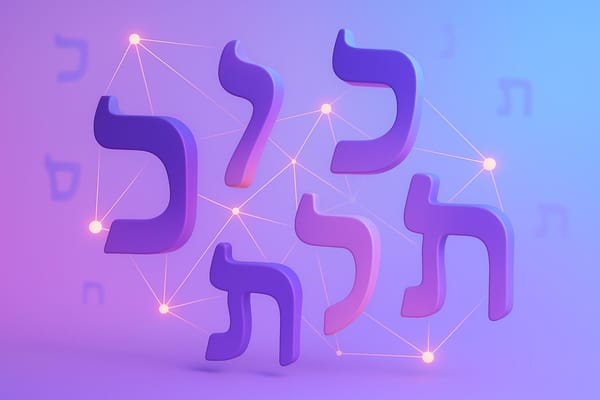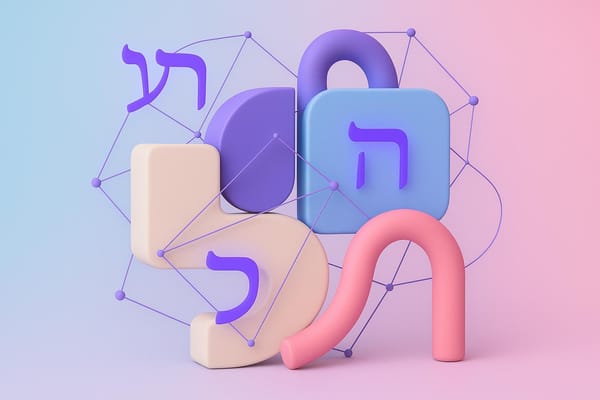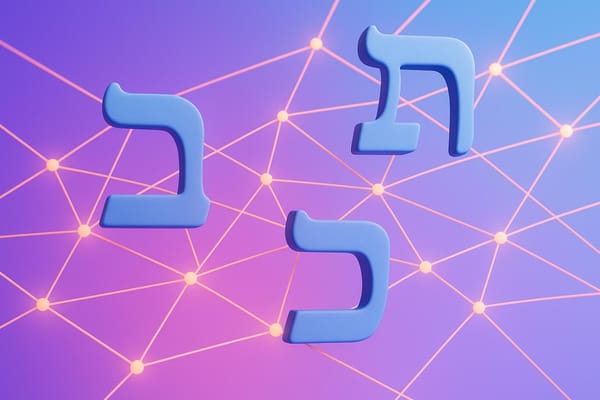Hebrew Alphabet: Learn to Read in 1 Week
Master the Hebrew alphabet in just one week with this step-by-step guide to reading and writing basics.

Want to read Hebrew in just 7 days? Here's how. This guide breaks down the Hebrew alphabet (Alef Bet) into an easy-to-follow plan. By dedicating a little time each day, you can master the basics of Hebrew letters, vowels, and simple words. Here's the 1-week roadmap:
- Days 1-2: Learn the first 11 letters and their sounds.
- Days 3-4: Master the remaining 11 letters and vowel marks (nikkud).
- Days 5-6: Practice forming words and recognizing patterns.
- Day 7: Review, practice reading sentences, and reinforce your skills.
The Hebrew Alphabet: Crash Course in Hebrew Reading & Pronunciation
Days 1-2: Basic Letters and Sounds
Start your journey into Hebrew by focusing on the first 11 letters of the alphabet. These two days are all about laying a solid foundation, helping you get comfortable with reading and writing.
First 11 Letters
Here are the first 11 Hebrew letters you'll learn, along with their names and sounds:
| Letter | Name | Sound |
|---|---|---|
| א | Alef | Silent (placeholder for vowels) |
| ב | Bet | B/V |
| ג | Gimel | G |
| ד | Dalet | D |
| ה | Hei | H |
| ו | Vav | V/O/U |
| ז | Zayin | Z |
| ח | Chet | Ch |
| ט | Tet | T |
| י | Yud | Y |
| כ | Kaf | K/Ch |
Repetition is your best friend here. Spend time reviewing these letters daily to reinforce your memory and build confidence.
Basic Writing Practice
Get familiar with writing each letter by starting with large, bold strokes to learn their shapes and direction. As you improve, make your writing smaller and more precise. Apps like Write It! Hebrew can guide you through proper right-to-left writing techniques.
Helpful Tools and Apps
Boost your learning with apps like Write It! Hebrew for writing practice or Memrise for flashcard exercises. Aim to practice for at least 30 minutes twice a day to solidify your understanding of these initial letters.
Days 3-4: Advanced Letters and Vowels
Now that you've covered the first 11 letters, it’s time to complete the Hebrew alphabet and dive into the vowel system. Over the next two days, you’ll focus on the remaining letters and learn the vowel marks that bring Hebrew words to life.
Remaining 11 Letters
The final group of Hebrew letters includes five special forms called "sofit" letters. These appear only at the end of words but share the same pronunciation as their standard counterparts. Recognizing these variations is key to reading fluently.
| Letter | Name | Sound | End Form |
|---|---|---|---|
| ל | Lamed | L | - |
| מ | Mem | M | ם |
| נ | Nun | N | ן |
| ס | Samech | S | - |
| ע | Ayin | Silent | - |
| פ | Peh | P/F | ף |
| צ | Tzadik | Tz | ץ |
| ק | Kuf | K | - |
| ר | Resh | R | - |
| ש | Shin | Sh/S | - |
| ת | Tav | T | - |
As John J. Parsons, author of Hebrew for Christians, explains:
"The five sofit letters sound the same as their non-sofit cousins, so you do not have to learn any new sounds; however, you will need to be able to recognize these letters at the end of a word."
Vowel Marks Guide
With the alphabet almost complete, it’s time to tackle vowels. Hebrew vowels, or nekudot, are small symbols that indicate pronunciation.
| Vowel Type | Symbol | Name | Sound |
|---|---|---|---|
| AH | אָ | Kamatz | Long "ah" |
| AH | אַ | Patach | Short "ah" |
| EH | אֶ | Segol | Short "eh" |
| EE | אִ | Chirik | "ee" |
| OH | אֹ | Cholam | "oh" |
| OO | וּ | Shuruk | "oo" |
Start by combining these vowels with the letters you’ve learned. Begin with simple pairings, then move on to more complex combinations. A Hebrew Essentials Chart can help you see how vowels interact with consonants, making it easier to form words.
Although modern Hebrew often skips vowels in writing, learning them now will give you a solid foundation for reading. With the full alphabet and vowel system in hand, you’re ready to start forming words and exploring basic Hebrew structures.
Days 5-6: Word Formation
With the alphabet and vowels under your belt, it's time to take the next step: forming words and spotting patterns. Over these two days, you'll combine what you've learned to start reading Hebrew words with greater ease.
Letter-Vowel Combinations and Common Words
Here are some basic Hebrew word formations to practice. They show how consonants and vowels come together:
| Word | Pronunciation | Meaning | Formation |
|---|---|---|---|
| שָׁלוֹם | sha-LOM | peace/hello | ש + ָ + ל + וֹ + ם |
| סֵפֶר | SE-fer | book | ס + ֵ + פ + ֶ + ר |
| בָּרוּךְ | ba-RUKH | blessed | ב + ָ + ר + וּ + ך |
| אָב | AV | father | א + ָ + ב |
Basic Letter Patterns
Hebrew words often follow clear and predictable patterns, making them easier to read:
- Prefixes: Common ones include ב (in), ל (to), and מ (from).
- Sofit letters: These special forms (ם, ן, ף, ץ, ך) only appear at the end of words.
- Roots: Most Hebrew words stem from three-letter roots that carry a central meaning. For instance, the root ש-ל-מ relates to peace and wholeness, found in words like שָׁלוֹם (shalom, peace) and מִשְׁלוֹם (mishlom, payment).
"Mastering nikkud and starting with simple words builds fluency. Gradually progress to longer words." - Dr. Sarah Benor [1]
With these tools, you'll soon be ready to tackle full sentences and sharpen your reading skills on Day 7.
Day 7: Practice and Review
Day 7 is all about strengthening your Hebrew reading skills through consistent practice and reviewing what you’ve learned so far.
Basic Sentence Reading
Here are a few simple Hebrew sentences to practice:
| Hebrew | Pronunciation | Meaning |
|---|---|---|
| בוקר טוב | bo-ker tov | Good morning |
| ערב טוב | e-rev tov | Good evening |
| מה שלומך? | ma shlo-m'cha? | How are you? |
| תודה רבה | to-dah ra-bah | Thank you very much |
Essential Skills Checklist
Make sure you’re comfortable with these key skills:
- Letter Recognition: Identify all 22 Hebrew letters with ease.
- Vowel Marks: Understand and read the nikkud (vowel system).
- Final Letters: Spot the five sofit (final) letter forms.
- Word Formation: Combine letters and vowels to form basic words.
- Simple Sentences: Read short phrases clearly and accurately.
"Having trouble staying on track? The Basic Lesson Checklist will help you stay organized and committed to your Hebrew language goals!" - HebrewPod101 Team [1]
Once you’ve nailed these basics, you can explore additional tools to deepen your understanding.
Learning Tools
Here are some useful resources to support your learning:
- baba - Smart Hebrew Translation: This platform offers interactive lessons and exercises. Simya Solutions Ltd notes, “The app's gamified approach appeals to young and old alike, and its interactive features make language acquisition a fun process.” [2]
- Digital flashcards: Perfect for practicing letter and vowel recognition.
- Downloadable Hebrew worksheets: Great for hands-on practice.
Consistency is key to building confidence in Hebrew reading. These tools and regular engagement will help you make steady progress.
Conclusion
Week's Progress Summary
Learning the Hebrew alphabet in just one week is possible with focus and the right approach. By following this structured plan, you've gained a solid understanding of Hebrew letters, vowels, and basic word formation. This foundation sets you up for continued progress in reading and understanding Hebrew.
Future Learning Steps
Now that you've completed the 7-day plan, it's time to build on your skills and take them to the next level.
Reading and Practice
- Start reading texts without vowel markings to improve recognition.
- Use children's books for simple vocabulary and sentence structure.
- Explore modern Hebrew newspapers and online content for real-world practice.
- Join language exchange groups to interact with native speakers.
- Leverage advanced tools in apps like baba for further practice.
Here's a helpful framework to guide your progression:
| Stage | Focus Area | Learning Activity |
|---|---|---|
| Foundation | Complex Vowel Patterns | Practice using different niqqud combinations. |
| Intermediate | Word Recognition | Read short paragraphs without vowel marks. |
| Advanced | Fluency Building | Engage with native content and audio. |
Dedicate 20–30 minutes daily to these activities. Gradually introduce more complex texts while revisiting the basics you've mastered. This consistent practice will help you strengthen your skills and gain confidence in reading Hebrew.





